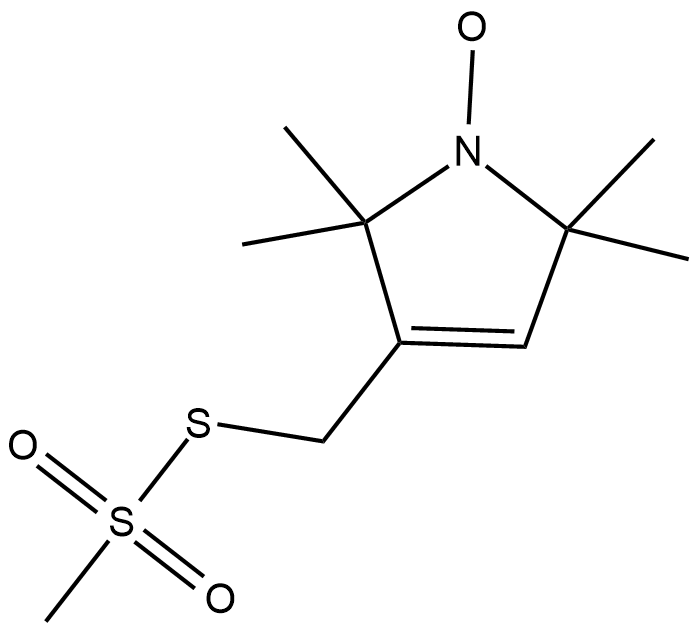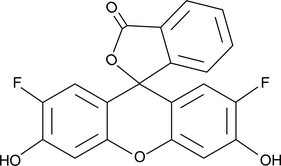Reactive Probes
Products for Reactive Probes
- Cat.No. Product Name Information
-
GC40702
α-D-Galactopyranosylphenyl isothiocyanate
α-D-Galactopyranosylphenyl isothiocyanate is a chemically activated form of galactose that has been used to prepare various neoglycoproteins, which consist of a glycosylated serum albumin substituted with either fluorescein or methotrexate.

-
GC41944
16-Doxylstearic Acid
A hydrophobic spin label

-
GC49651
19-alkyne Cholesterol
An alkyne derivative of cholesterol for click chemistry

-
GC42339
4'-Aminomethyl-4,5',8-trimethylpsoralen
4'-Aminomethyl-4,5',8-trimethylpsoralen is a bifunctional photoreactive agent for crosslinking nucleic acids.

-
GC40498
4-oxo-2-Nonenal Alkyne
4-oxo-2-Nonenal is a product of lipid peroxidation that actively modifies histidine and lysine residues on proteins and causes protein cross-linking.

-
GC49339
5(6)-Carboxy-2′,7′-dichlorofluorescein diacetate
An oxidant-sensitive fluorescent probe

-
GC49245
5-Ethynyluridine
5-Ethynyluridine (5-EU) is a potent cell-permeable nucleoside can be used to label newly synthesized RNA.

-
GC49312
7-Fluoro-2,1,3-benzoxadiazole-4-sulfonate (ammonium salt)
7-Fluoro-2,1,3-benzoxadiazole-4-sulfonate (ammonium salt) is a fluorescent label.

-
GC42642
9,10-Anthracenediyl-bis(methylene)dimalonic Acid
9,10-Anthracenediyl-bis(methylene)dimalonic acid (ABMDMA) is a reagent used to detect singlet oxygen generation.

-
GC42765
Aldehyde Reactive Probe (trifluoroacetate salt)
DNA is continually damaged by endogenous and environmental agents leading to the formation of abasic (apurinic/apyrimidinic, AP) sites that are disruptive to DNA synthesis.

-
GC49331
AMCA N-succinimidyl ester
AMCA N-succinimidyl ester is a bioReagent, suitable for fluorescence, can be used for amine-reactive labeling.

-
GC41583
BCN-E-BCN
BCN-E-BCN is a strained cycloalkyne probe for detecting proteins that have been sulfenylated, the first intermediate step in protein oxidation.

-
GC41445
DAz-1
Redox-sensitive cysteine residues in proteins may function as sensors of reactive oxygen species (ROS) and also serve as molecular switches, activating or deactivating proteins, following a change in oxidation state.

-
GC43382
DAz-2
DAz-2 is a cell-permeable chemical probe used to detect cysteine oxidation in proteins.

-
GC43410
DEPMPO
DEPMPO is a phosphorylated derivative of the widely used DMPO spin trap.

-
GC43481
Disuccinimidyl Sulfoxide
Disuccinimidyl sulfoxide (DSSO) is a protein cross-linking probe designed to be used with mass spectrometry (MS).

-
GC48994
Girard’s Reagent P-d5
An internal standard for the quantification of Girard’s reagent P

-
GC43887
IBTP (iodide)
IBTP is a lipophilic cation that is accumulated in mitochondria and forms stable thioether adducts in a thiol-specific manner.

-
GC44253
MTSEA-biotin
MTSEA-biotin is a thiol-reactive probe that can be used to label proteins at cysteine residues.

-
GC44254
MTSES
Methanethiosulfonates (MTS) are sulfhydryl-reactive compounds that form mixed disulfide linkages and are commonly used to study cysteine residues on proteins.

-
GC44255
MTSET (chloride)
MTSET (chloride) is a methanethiosulfonate (MTS), a sulfhydryl-reactive compound that forms mixed disulfide linkages.

-
GC18465
MTSSL
MTSSL is a paramagnetic nitroxide spin label featuring a methanethiosulfonate group for site-directed spin labeling, particularly through disulfide linkages with cysteine residues on proteins.

-
GC49621
Oregon Green™ 488
A fluorinated fluorescein dye

-
GC44634
Phosphine-biotin
Labeling reactive centers of various types in cells with specific site-directed probes is a common method to explore both function and biochemical modification of proteins.

-
GC49691
PSP
A two-photon fluorescent probe for H2Sn

-
GC41219
S-Phenylsulfonylcysteine
S-Nitrosylation reactions regulate protein function and mediate nitrosative stress.

-
GC44909
SNOB 1 Reagent
SNOB 1 Reagent is a biotinylated probe for detecting S-nitrosylated proteins in a single step.

-
GC40102
YnMyr Diazirine X10
YnMyr Diazirine X10 is a cell-permeable photoreactive probe for protein myristoylation.



